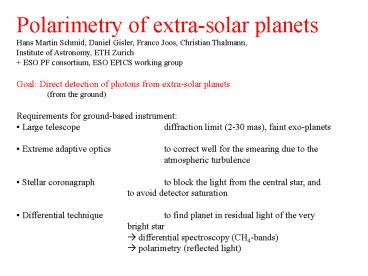Polarimetry of extrasolar planets - PowerPoint PPT Presentation
1 / 7
Title:
Polarimetry of extrasolar planets
Description:
Stellar coronagraph to block the light from the central star, and. to avoid detector saturation ... 'perfect' Lyot coronagraph. R-band observation. photon noise ... – PowerPoint PPT presentation
Number of Views:33
Avg rating:3.0/5.0
Title: Polarimetry of extrasolar planets
1
- Polarimetry of extra-solar planets
- Hans Martin Schmid, Daniel Gisler, Franco Joos,
Christian Thalmann, - Institute of Astronomy, ETH Zurich
- ESO PF consortium, ESO EPICS working group
- Goal Direct detection of photons from
extra-solar planets - (from the ground)
- Requirements for ground-based instrument
- Large telescope diffraction limit (2-30 mas),
faint exo-planets - Extreme adaptive optics to correct well for
the smearing due to the atmospheric
turbulence - Stellar coronagraph to block the light from
the central star, and - to avoid detector saturation
- Differential technique to find planet in
residual light of the very - bright star
- ? differential spectroscopy (CH4-bands)
2
Example Sun Jupiter system at 5 pc
1
X-AO
tiny planetary signal in bumpy and variable PSF
halo
3
Solar system planets surface properties
p(90) f(90) rocky Mercury 5-10
low Mars 5-10 low cloudy (little
Rayleigh scatt.) Venus lt5 () high
Saturn lt5 high cloudy and Rayleigh
scatt. Jupiter 5-20 high Earth
5-20 high strong Rayleigh scattering Uranus
gt15 med. Neptune gt15 med. Titan
50 med.
polarization p(90) vs. reflectivity f(90)
R-band
from Schmid et al. 2005
4
Polarimeter implementation in a planet finder
instrument
- mutual constraints
- Polarimeter should not affect AO
- system and other instrument parts
- AO design, telescope, etc. should
- not destroy polarization signal
- VLT planet finder (design study)
- OWL EPICS (concept study)
telescope
pol.-switch
AO adaptive optics
near-IR instruments
?gt0.95µ ?lt0.9µ
imaging polarimeter
coronagraph
BS
BS
WFS wave front sensor
to be build by ETH
5
Status of the PF-project PF VLT 2nd generation
instrument 2001 call for proposals 2003/2004
two competing phase A studies 2005 merging of
the two concepts and consortia early 2006 start
design phase 2010 first light
6
- OWL ESOs 100m ELT project
- (highest priority for ESO)
- 2005
- telescope feasibility studies
- instrument concept studies
- EPICS planetary camera with
- polarimetric mode
7
Expected performance for VLT and
OWL Polarization contrast Cpol p
fplanet/fstar p(a) f(a) Rp2/dp2
VLT
OWL
- Assumptions
- solar system analog at 5pc
- integration 4h
- perfect Lyot coronagraph
- R-band observation
- photon noise limit reached
- ? residual speckle noise negligible
- ? 10-5 polarimetric precision reached































